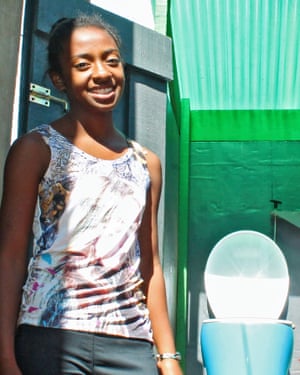American design student Virginia Gardiner did not expect to end up finding her muse in a toilet, or find power and profit out of poo.
She also did not expect to find herself and the waterless toilet she designed for wasteful westerners (originally it was embraced by posh festivalgoers), on the island of Madagascar, piloting a system that turns faecal waste into biogas.
“I didn’t even know about the global sanitation crisis,” says Gardiner, who founded the London-based company Loowatt in 2008. “I wanted to turn the idea of a flushed toilet on its head and say that there should be a waterless toilet that turns shit into a commodity.”
Loowatt’s system of an odourless, waterless and contactless toilet, involves a biodegradable liner that wraps human waste and is pulled into a cartridge with the foot pedal. The cartridges are either emptied into micro-scale digesters on site, or into larger digesters at plants. Then the waste and liners are turned into biogas to power electric lights, batteries or gas cookers, or are turned into organic fertiliser.
The model impressed judges at RELX Group Environmental Challenge which awarded LooWatt the first prize, and $ 50,000, in the competition for the world’s best sustainable water and sanitation projects that was announced this week at SIWI World Water Week.
The UN estimates that around 2.5 billion people in the developing world don’t have access to a toilet and Madagascar is the fourth-worst place in the world to find one.
Loowatt was drawn into the field of development in 2011. One of its first investors was living in Madagascar’s hilly capital Antananarivo and invited Gardiner to see the state of sanitation there, starting with the low-lying neighbourhoods where most waste washes up.
“Everywhere you look, you just see faeces,” she recalls. “You can’t look around for more than a few seconds without seeing evidence of faecal contamination, children playing around it and leafy vegetables growing in or around cesspools.”
The problem, especially in a city where the water table is only a few feet below the earth, comes from pit latrines being flooded by rains, or people in crowded areas being forced to dump on their own doorstep.
“People, especially women and children, don’t like to leave the house at night so they use buckets, and very often you’ll see people emptying them into the canals as there’s just nowhere else to put it,” says Gardiner. Mothers are terrified of their children drowning in metres-deep slime pits when wooden latrine platforms rot and give way.

Only half of the capital’s residents have access to water and three-quarters have to rely on latrines that are “a ticking time-bomb when it comes to fecal pathogens”, Gardiner says. She explains that as a latrine is a hole in the ground, flies can go in an out and then might land on food. This has caused diarrhoea-related diseases that have stunted more than half the island’s children due to malnutrition.
Even if Antananarivo’s residents were conscientious about where they dumped their waste, the city of two million people has no working wastewater plant. “Ninety-eight percent of those latrines are emptied by unregulated service providers, so basically the faecal sludge is being dumped all over the city or in rivers just outside,” says Gardiner.
In 2012, with pilot funding from the Bill & Melinda Gates Foundation, Loowatt launched its first model in Madagascar named Tsiky, which is Malagasy for “smile”. It launched in Antananarivo’s worst neighbourhoods to see whether it could tackle a problem that charities have found hard to fix.
“Latrines have been considered the toilet for Africa by NGOs,” says Gardiner. “But they become vectors of disease upon emptying or flooding.”
Loowatt has installed 70 toilets in the capital and will complete its pilot of 100 by the end of the year. “Our hope is that the Madagascar business can create a strong data set to support how the business can scale globally, in Madagascar, but also in cities all over the developing world,” says Gardiner.
Customers are pleased that they can ‘make money off this shit’ by generating power for the community
Loowatt calculates its success on how frequently people buy cartridge refills that cost roughly $ 1.10 and should last a week. Despite 92% of Madagascar’s population living below the poverty line , Loowatt has 90% repeat weekly purchases.
Customers say that they “don’t hesitate” to use the toilet and don’t worry about their children using it. Others are pleased that they can “make money off this shit” by generating power for the community.
Gardiner says that there is demand for their toilets all over sub-Saharan Africa and parts of Asia, and that requests from events or wedding organisers, once limited to the UK, have now hit Madagascar.
In Madagascar a small office manages everything from printing 3D parts and importing others, to finding local waste collectors, treatment centres and businesses that would use its electricity. Loowatt is looking for the right partners and funding to scale up the business next year.
Gardiner sees this work as the next step in proving that Africa and the rest of the developing world is ready for, and deserves, better basic services for people’s most intimate ritual. “It’s about changing the mentality away from thinking that basic, rudimentary technology is going to be good enough.” And as for the dangerous, disease-ridden and sometimes deadly latrines “the view of them is changing,” says Gardiner. “People see that maybe these are not good enough.”
Join our community of development professionals and humanitarians. Follow @GuardianGDP on Twitter, and have your say on issues around water in development using #H2Oideas.
The designer loo revolutionising Madagascar"s toilet crisis
Hiç yorum yok:
Yorum Gönder